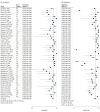Diagnostic Performance of Electronic Noses in Cancer Diagnoses Using Exhaled Breath: A Systematic Review and Meta-analysis
- PMID: 35767259
- PMCID: PMC9244610
- DOI: 10.1001/jamanetworkopen.2022.19372
Diagnostic Performance of Electronic Noses in Cancer Diagnoses Using Exhaled Breath: A Systematic Review and Meta-analysis
Abstract
Importance: There has been a growing interest in the use of electronic noses (e-noses) in detecting volatile organic compounds in exhaled breath for the diagnosis of cancer. However, no systematic evaluation has been performed of the overall diagnostic accuracy and methodologic challenges of using e-noses for cancer detection in exhaled breath.
Objective: To provide an overview of the diagnostic accuracy and methodologic challenges of using e-noses for the detection of cancer.
Data sources: An electronic search was performed in the PubMed and Embase databases (January 1, 2000, to July 1, 2021).
Study selection: Inclusion criteria were the following: (1) use of e-nose technology, (2) detection of cancer, and (3) analysis of exhaled breath. Exclusion criteria were (1) studies published before 2000; (2) studies not performed in humans; (3) studies not performed in adults; (4) studies that only analyzed biofluids; and (5) studies that exclusively used gas chromatography-mass spectrometry to analyze exhaled breath samples.
Data extraction and synthesis: PRISMA guidelines were used for the identification, screening, eligibility, and selection process. Quality assessment was performed using Quality Assessment of Diagnostic Accuracy Studies 2. Generalized mixed-effects bivariate meta-analysis was performed.
Main outcomes and measures: Main outcomes were sensitivity, specificity, and mean area under the receiver operating characteristic curve.
Results: This review identified 52 articles with a total of 3677 patients with cancer. All studies were feasibility studies. The sensitivity of e-noses ranged from 48.3% to 95.8% and the specificity from 10.0% to 100.0%. Pooled analysis resulted in a mean (SE) area under the receiver operating characteristic curve of 94% (95% CI, 92%-96%), a sensitivity of 90% (95% CI, 88%-92%), and a specificity of 87% (95% CI, 81%-92%). Considerable heterogeneity existed among the studies because of differences in the selection of patients, endogenous and exogenous factors, and collection of exhaled breath.
Conclusions and relevance: Results of this review indicate that e-noses have a high diagnostic accuracy for the detection of cancer in exhaled breath. However, most studies were feasibility studies with small sample sizes, a lack of standardization, and a high risk of bias. The lack of standardization and reproducibility of e-nose research should be addressed in future research.
Conflict of interest statement
Figures



Similar articles
-
Accuracy and Methodologic Challenges of Volatile Organic Compound-Based Exhaled Breath Tests for Cancer Diagnosis: A Systematic Review and Meta-analysis.JAMA Oncol. 2019 Jan 1;5(1):e182815. doi: 10.1001/jamaoncol.2018.2815. Epub 2019 Jan 10. JAMA Oncol. 2019. PMID: 30128487 Free PMC article.
-
Diagnostic performance of volatile organic compounds analysis and electronic noses for detecting colorectal cancer: a systematic review and meta-analysis.Front Oncol. 2024 May 13;14:1397259. doi: 10.3389/fonc.2024.1397259. eCollection 2024. Front Oncol. 2024. PMID: 38817891 Free PMC article.
-
Diagnosing Non-Small Cell Lung Cancer by Exhaled Breath Profiling Using an Electronic Nose: A Multicenter Validation Study.Chest. 2023 Mar;163(3):697-706. doi: 10.1016/j.chest.2022.09.042. Epub 2022 Oct 13. Chest. 2023. PMID: 36243060
-
Accuracy of the Electronic Nose Breath Tests in Clinical Application: A Systematic Review and Meta-Analysis.Biosensors (Basel). 2021 Nov 22;11(11):469. doi: 10.3390/bios11110469. Biosensors (Basel). 2021. PMID: 34821685 Free PMC article.
-
Infrared Spectroscopic Electronic Noses: An Innovative Approach for Exhaled Breath Sensing.ACS Sens. 2025 Jan 24;10(1):427-438. doi: 10.1021/acssensors.4c02725. Epub 2025 Jan 8. ACS Sens. 2025. PMID: 39772459 Free PMC article.
Cited by
-
Breath Volatile Organic Compounds in Surveillance of Gastric Cancer Patients following Radical Surgical Management.Diagnostics (Basel). 2023 May 9;13(10):1670. doi: 10.3390/diagnostics13101670. Diagnostics (Basel). 2023. PMID: 37238155 Free PMC article.
-
Acoustic metasurface constructed by periodic parallel Helmholtz resonators for gas sensing applications.Sci Rep. 2025 Jul 8;15(1):24345. doi: 10.1038/s41598-025-04253-4. Sci Rep. 2025. PMID: 40624101 Free PMC article.
-
Volatile Organic Compounds in Biological Matrices as a Sensitive Weapon in Cancer Diagnosis.Pharmaceuticals (Basel). 2025 Apr 27;18(5):638. doi: 10.3390/ph18050638. Pharmaceuticals (Basel). 2025. PMID: 40430459 Free PMC article. Review.
-
Exploring Components, Sensors, and Techniques for Cancer Detection via eNose Technology: A Systematic Review.Sensors (Basel). 2024 Dec 9;24(23):7868. doi: 10.3390/s24237868. Sensors (Basel). 2024. PMID: 39686404 Free PMC article.
-
Breaking barriers in Candida spp. detection with Electronic Noses and artificial intelligence.Sci Rep. 2024 Jan 10;14(1):956. doi: 10.1038/s41598-023-50332-9. Sci Rep. 2024. PMID: 38200060 Free PMC article.
References
Publication types
MeSH terms
LinkOut - more resources
Full Text Sources
Medical

